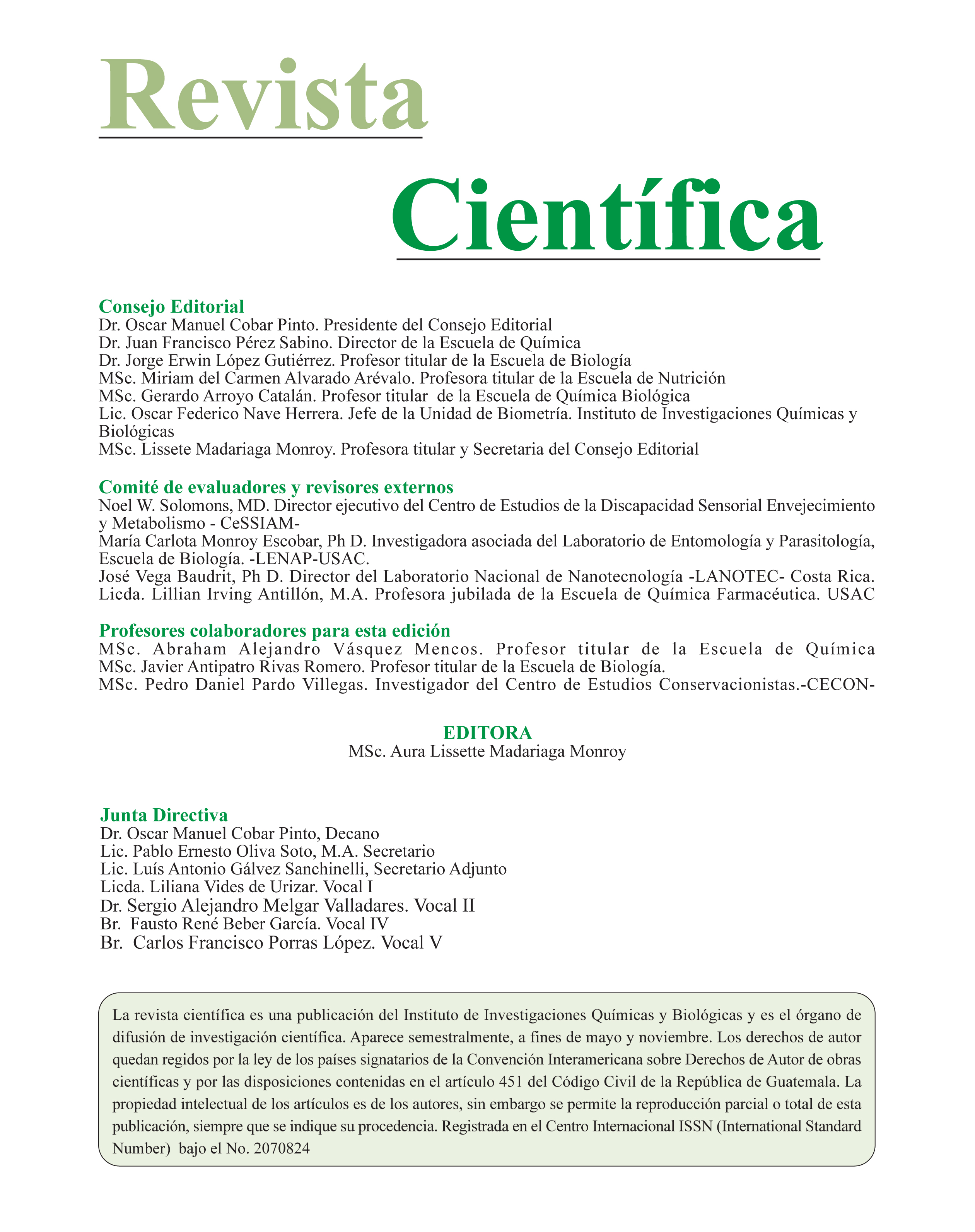Impact of the microbiological quality of external air on the internal environment of four laboratories of public institutions in Guatemala City and Bárcenas, Villa Nueva
DOI:
https://doi.org/10.54495/Rev.Cientifica.v22i1.120Keywords:
Aerobiology, Microbiological air quality, bacterial load, fungical load, aeroscopeAbstract
A research regarding the microbiological air quality was done in four laboratories, three of them were located in Guatemala city - Laboratorio Microbiológico de Referencia (LAMIR), Laboratorio de Análisis Fisicoquímico y Microbiológico (LAFYM), Laboratorio de la Empresa Municipal de Agua (EMPAGUA) -and one in the town of Barcenas Villa Nueva - Laboratorio de la Autoridad en el Manejo Sustentable del Lago de Amatitlán (AMSA) -. The results were obtained using the volumetric method by impaction using a monthly sampling biocolector in the months October 2,008 to March 2,009. The highest fungal load in the indoor environment was presented by the laboratory of EMPAGUA (8100 UFC/m3), meanwhile in the outdoor environment was the AMSA laboratory (14460 UFC/m3). The AMSA laboratory showed the highest bacteriological load, both indoor and outdoor (2630 UFC/m3 and 6780 UFC/m3 respectively). This values were found to be over the regulation applied by the OSHA for the fungical load (2000 UFC/m3) and the bacterial load (1000 UFC/m3).Seventeen fungal genera were isolated and characterized; Cladosporium, Penicillium and Aspergillus dominated in the course of the six monthly samplings, and 40 bacteriological genera were isolated and characterized: Staphylococcus and Bacillus were the dominating genera.
Downloads
References
Aydogdu H. & Ahmet A. (2005). Monitoring of fungi and bacteria in the Indoor air of primary school in Edirne, Turkey, Indoor Built Environ, 14(5) 411-425. https://doi.org/10.1177/1420326X05057539 DOI: https://doi.org/10.1177/1420326X05057539
Castañeda E., Montes M. y Avelino F., (2006). Cuantificación de bioaerosoles en las áreas de proceso de una industria zapatera y su relación con la salud de los trabajadores, Enfermedades Infecciosas y microbiología. 26:1-5.
Flores F. J., Pardavé L.M. y Valenzuela I.C. (2007). Estudio aerobiológico de la zona aledaña al relleno sanitario “San Nicolás”. Municipio de Aguas Calientes. México. Investigación y Ciencia UAA. 37: 13-18
García N., Araujo I. y Fernández M. (2005). Calidad microbiológica y fisicoquímica del aire en tres laboratorios de la Facultad de Ingeniería de la Universidad del Zulia. CIEN, 13(2):182-192.
Gordon B, Mackay R & Rehfuess E. (2004). Inheriting the World: The atlas of children’s health and the environment, Geneva: World Health Organization, p.1-2.
Harrison J., Pickerin C.A., Faragher E.B., Austwick P.K., Little S.A. & Lawton L. (1992).An investigation of the relationship between microbial and particulate indoor air pollution and the sick building syndrome. U.K., Respire Med; 86: 225-235. https://doi.org/10.1016/S0954-6111(06)80060-0 DOI: https://doi.org/10.1016/S0954-6111(06)80060-0
Klanova, K. (2000). The concentrations of mixed populations of fungi in indoor air: romos with and without mould problems romos with and without health complaints. Central European Journal of Public. Health.8: 59.61.
Madigan MT., Martinko JM., Dunlap PV. y Clark DP. (2009). Biología de los microorganismos. (12ª ed.). Madrid, España: Pearson Prentice-Hall, p. 46, 86.
Rico M. (1998). Fundamentos de Microbiología. Santa Fe de Bogotá, Colombia: Centro Editorial Javeriano., p. 27-32.
Sánchez M., Díaz E., Cobas, G., Amils R., Sánchez, B. (2000). Caracterización de microorganismos en aire interior de la universidad autónoma de Madrid, Laboratorio de aplicaciones ambientales, Facultad de Ciencias, Universidad Autónoma de Madrid, España, p. 3.
Occupational Safety and Health Administration, Indoor Air Quality, Occupational Safety and Health Administration (OSHA).(2001). Washington, D.C. Federal Register 66:64946 . gov.
Organización Mundial de la Salud. (1997). Guía para la calidad del aire. Trad: Centro Panamericano de Ingeniería Sanitaria y Ciencias del Ambiente (CEPIS/OPS). Ginebra, Suiza.
Downloads
Published
How to Cite
Issue
Section
License
Copyright (c) 2012 K. Herrera, O. Cobar, J. De León, A. Rodas, S. Boburg, J. Quan, L. Pernilla, C. Mancilla, H. Gudiel

This work is licensed under a Creative Commons Attribution 4.0 International License.
Authors who publish with this journal agree to the following terms:
- Authors retain copyright and grant the journal right of first publication with the work simultaneously licensed under a Creative Commons Attribution License 4.0 that allows others to share the work with an acknowledgement of the work's authorship and initial publication in this journal.
- Authors are able to enter into separate, additional contractual arrangements for the non-exclusive distribution of the journal's published version of the work (e.g., post it to an institutional repository or publish it in a book), with an acknowledgement of its initial publication in this journal.
- Authors are permitted and encouraged to post their work online (e.g., in institutional repositories or on their website) prior to and during the submission process, as it can lead to productive exchanges, as well as earlier and greater citation of published work.









